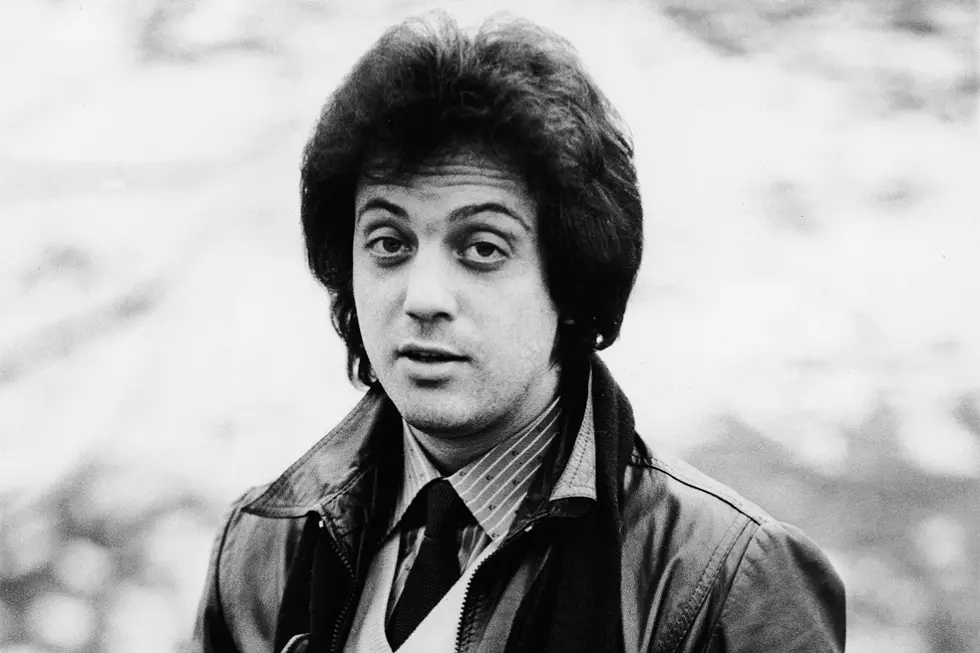
Why Billy Joel Toughened Up on ‘Glass Houses’
Billy Joel closed out the '70s with two of the bestselling albums of the decade in The Stranger and 52nd Street. But instead of getting complacent after finally tasting success following years of hard work — and occasionally bitter disappointment — fame just added sharper corners and greater heft to the chip he had on his shoulder.
That was the impression given, anyway, by Joel's seventh solo effort, Glass Houses, which arrived in March 1980. Right from the cover, which depicted a leather jacket-clad Joel preparing to toss a rock through the front window of a very nice place, the album signaled a tougher Billy than the one who'd peered forlornly out at the listener from the cover of 52nd Street, wearing a tie and clutching a trumpet.
"I was taking quite a critical pasting by 52nd Street because of the commercial success that I had," Joel told In the Studio in 2010. "I was aware that there had been a great deal of, I guess we could call it, ‘Billy Joel Saturation’ for close to three years."
As he went on to explain, part of his shift in sound and image came from the knowledge that he had to prove he was more than the artist people recognized from his recent hits. "I could have come out with a record that would have guaranteed a certain amount of sales – just by repeating either The Stranger album or the 52nd Street album, by doing something similar," he said. "Frankly, I would have been bored to do that. I would have been a dead duck, career-wise. You have to discard an audience to pick up another one."
"It’s a definite temptation to repeat a successful formula. But I have never done the same thing twice. I don’t care what anybody says," Joel told Playboy in 1982. "After Stranger, I could have done Son of Stranger, but I’ve never done that. To keep me interested, there always has to be something new, something different."
In addition to audience and songwriting concerns, Joel realized as the '80s dawned that he'd graduated to a different level of venue as his sales skyrocketed, and he needed to come up with material more suited to bigger buildings and larger crowds.
"We'd had two or three years of playing in arenas and coliseums, and I recognized that I needed to write bigger music," said Joel in a 2011 interview. "Ballads don't always fly that well in an arena; you need big sound. So I started harder-edged songs, more guitar-based songs. ... It was fun to do. This was probably the most fun album that I ever made. It happened fairly quickly, the band loved playing it, the audiences loved the material that was on the recording and we were on a roll."
Part of the fun, Joel later pointed out, was willfully destroying his increasingly soft image — and not just by upping the guitar quotient on the record. As he revealed after Glass Houses was released, that photo of him holding a rock was something of an inside joke. "That's actually the house I was living in at the time," Joel noted of the cover shot. "I saw a photo and I thought, 'People who live in glass houses shouldn't throw stones,' and the name stuck."
But there was also a subtext: "It was, 'I’m going to throw a rock at the image people have of me as this mellow balladeer,'" he explained to Playboy. "We had been doing rock ‘n’ roll before, but there happened to be more of it on this record. The old thing about people who live in glass houses shouldn’t throw stones — I don’t believe it. I think, 'Why not? Take chances.' I really wanted to throw a rock at my own house."
Watch Billy Joel Perform 'You May Be Right'
Some of the same critics who accused Joel of relying too heavily on ballads were just as quick to suggest that Glass Houses was an attempt to glom onto some of the trendier sounds he name-checked in "It's Still Rock and Roll to Me" — particularly, as Playboy pointed out during their conversation, New Wave acts like Elvis Costello.
"I like Elvis Costello, but I have never tried to duplicate anyone," Joel explained. "If I consciously try to emulate anybody, it’s the Beatles. I’ve tried to compose in a certain style — for instance, I was thinking of Ray Charles when I sat down to write 'New York State of Mind,' but that’s different. I am inspired by performers, but I don’t try to copy people. We didn’t set out to make Glass Houses New Wave. We looked at it as a rock ’n’ roll album."
As he argued in "It's Still Rock and Roll to Me," Joel saw the new trends he was accused of chasing as little more than new versions of old sounds. "It's just a reaction to a rediscovered past, and a rejection of Emerson, Lake and Palmer using multi-deck synthesizers," he told Rolling Stone of punk and New Wave in particular. "The Sex Pistols' 'God Save the Queen' bored the hell out of me.
"If I go to a disco and hear one boom-sup-boom tempo all night, I get a headache and split. If I go to a New Wave club and all I hear is 'Fuck you!' and the guy spits on me all night," Joel added. "I'm sorry. I don't like it. If I go to a folk club and all I hear is some girl strumming a guitar, singing, 'Give me some wine and cheese, please,' I don't want it. I would rather go and hear a good Top 40 bar band — which is what we still are, basically."
Few bar bands ever taste the level of success Joel enjoyed with Glass Houses, which gave him his second consecutive No. 1 album, third straight Top 5 album, and netted two Grammys against four nominations on its way to selling seven million copies. Glass Houses spawned four singles in the states, with "It's Still Rock and Roll to Me" hitting No. 1 and three more ("You May Be Right," "Don't Ask Me Why" and "Sometimes a Fantasy") reaching the Top 40. Billy Joel started the '80s the same way he ended the '70s — as one of the biggest rock stars on the planet — and his star would only continue to rise as the decade continued. But as he insisted in the wake of Glass Houses' triumph, he still felt like a blue-collar kid from Long Island.
"I’m not content. I’m content, though, not being content," Joel told Playboy. "I have a theory: I don’t think you ever are really satisfied. I don’t worry about being satisfied all the time. All I’m looking for is a little relief now and then."


